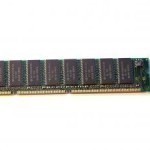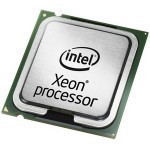PCI (Peripheral Component Interconnect) is a computer bus used for attaching peripheral devices to a computer motherboard. It is the most popular local I/O bus used in today. PCI provides a shared data path between the CPU and peripheral controllers in every computer models, from laptops to mainframes. Developed by the Intel Corporation, PCI first appeared in computers in 1993 and co-existed with the ISA bus for several years. It soon displaced the ISA and VESA local bus and became the standard expansion bus used in PCs. Today, most computers Read More
RAM (Random Access Memory)
RAM (Random Access Memory) usually refers to “temporary” memory, meaning that when the system is shut down, the memory is lost. This is why the memory is considered “random,” as any piece of information can be circulated through the memory regardless of its location and relation to any other information within the RAM. The first of the many RAMs to come in the market was created in 1951 and was used until the late 1960s and early 1970s. Types of RAMs The most widely used RAMs today are SRAMs (static Read More
Touch Screen Monitors
A touch screen is basically a display screen which can identify the occurrence and position of a touch within its own area. This usually refers to a touch or tap to the display of the gadget by a finger or hand. Touch screens can also identify added inactive objects, such as a stylus. Touch screens work by recognizing the pressure of a finger or stylus and then responding accordingly. For a touch screen to work, it needs a few basic parts. These parts, when combined together, allow the touch screen to Read More
Pentium
The Pentium family of processors is the current generation of CPU's for personal computers from Intel. Pentium processors trace their heritage all the way back to the original Intel 8088 CPU used in the original IBM-PC in 1981. Intel renamed the 80586 processor Pentium because of the difficulties of trademarking numbers. This was a move by Intel to create confusion in the marketplace which would reduce commodotization in the CPU market and allow them to retain higher profit margins in the face of low-cost competitors like AMD. Intel retained the Read More
SRAM (Static Random Access Memory)

SRAM, or Static Random Access Memory, is a type of memory device that stores accessed files and commands in a semi-permanent chip that only empties itself of stored data when it is no longer being powered, i.e. when the computer is unplugged or turned off. SRAM differs from DRAM, or Dynamic Random Access Memory, which stores data even when the computer is unplugged, but must be refreshed regularly to empty old data. While SRAM is highly efficient and very convenient for quick access, it is mostly only used to store Read More
Types of Computer Cases
A computer case, also termed as computer chassis or cabinet, is a small enclosure or box into which all the major computer components and peripherals are fitted. Computer cases can be broadly classified into 2 different categories. Each of them is briefly discussed below. Desktop Case: Considered the most classical version of computer cases, these are primarily designed for personal/business computers that are placed on top of a desk. The basic objective of these cases is to conserve the available desk space as the monitor is placed on top of Read More
Wireless Keyboards
To provide additional portability to computer users, IT manufacturers have created wireless keyboards that do not have to be kept at the user's desk. Wireless keyboards can be used by both desktop and laptop users as the technology used in wireless keyboards is universal to all computer models. While wireless keyboards may offer additional mobility for some computer users, however, they may not be for everyone. This article will explore the advantages and disadvantages of owning and using a wireless keyboard so that the user can make an informed decision Read More
Nouse

A Nouse is a new computer technology that has been invented and is being developed by Dr. Dmitry Gorodnichy from the Institute of Information Technology in Ottawa. The project is called Nouse Perceptual Vision User Interfaces, and is under the Video Recognitions Project. This is also known as Perceptual Vision Technology. This technology will enable computer users to use their eyes and nose as pointers in place of a conventional mouse pointer and will serve as a hands-free alternative for computer users. How It Works The face, most especially the Read More
Xeon

Xeon is an marketing name for Intel’s server-class CPUs from the Pentium family. Intel has manufactured and sold Xeon versions of the Pentium II, Pentium III, Pentium 4, and Pentium MP CPUs. Xeon CPUs are differentiated from each other by their CPU speeds, Front Side Bus speeds, and the size of their L2 cache and L3 cache. Current Xeon CPUs require the use of Dual Channel DDR or DDR2 SDRAM. Intel also manufactures low-voltage versions of the Xeon CPUs. In addition to reduced voltage, these Xeon’s also produce less heat. Read More
ATX Power Connector
ATX (Advanced Technology xTended) is a specification for motherboards created by Intel in 1995. It has replaced the AT standard and it is now incorporated into a wide variety of computer systems as the default motherboard layout. Although ATX is still very popular today, the microATX, FlexATX, and mini-ITX motherboard specifications have replaced it. The microATX, FlexATX, and mini-ITX are based on the same layout structure, but are much smaller and include more ports for expansions. The 2009 BTX (Balanced Technology Extended) release, which has been delayed due to heat Read More


Share on: